7 Tips for Better Customer Validation Interviews
Customer validation interviews are an important component of the product development process. Product managers use customer validation interviews to help inform product decisions by validating problems, solutions, and pain points.

7 Tips for Better Customer Validation Interviews
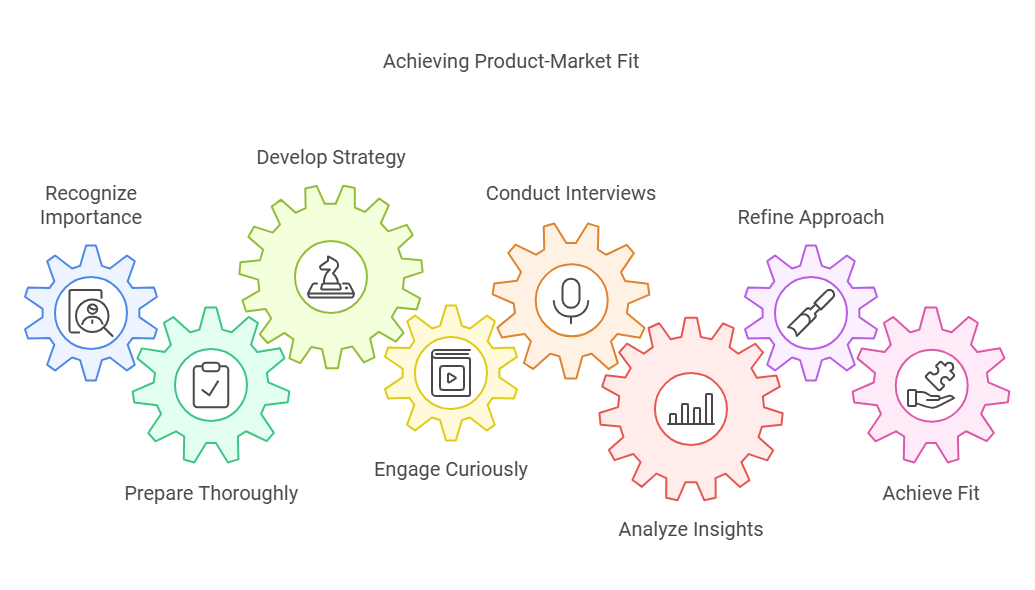
Introduction
Customer validation interviews are the cornerstone of building a product or service that truly resonates with your target audience. These interviews provide an opportunity to step into your customers' shoes, uncover their pain points, and understand their needs in a way that data alone cannot achieve. By engaging directly with users, businesses can move beyond assumptions, gathering actionable insights that drive meaningful improvements and informed decisions.
The process of conducting effective interviews goes beyond simply asking questions; it requires preparation, strategy, and a genuine curiosity to learn from your audience. In this blog, we will share nine actionable tips that will help you refine your approach, maximize the value of every interaction, and ultimately bring you closer to achieving product-market fit. Let’s begin with the foundation: preparation.
Section 1: Preparation is Key
Define Clear Goals and Hypotheses
Before diving into customer validation interviews, it is essential to establish a clear sense of purpose. Ask yourself: What do I hope to learn? What assumptions am I trying to validate? Defining specific goals and hypotheses gives structure to your interviews and ensures you gather insights that are relevant and actionable.
Start by listing your core hypotheses about the problem you’re solving or the value your product offers. For example, "Users find it difficult to track their spending habits," or "Customers prefer a mobile app over a desktop solution." These hypotheses will serve as a compass, guiding your questions and shaping the narrative of your interviews.
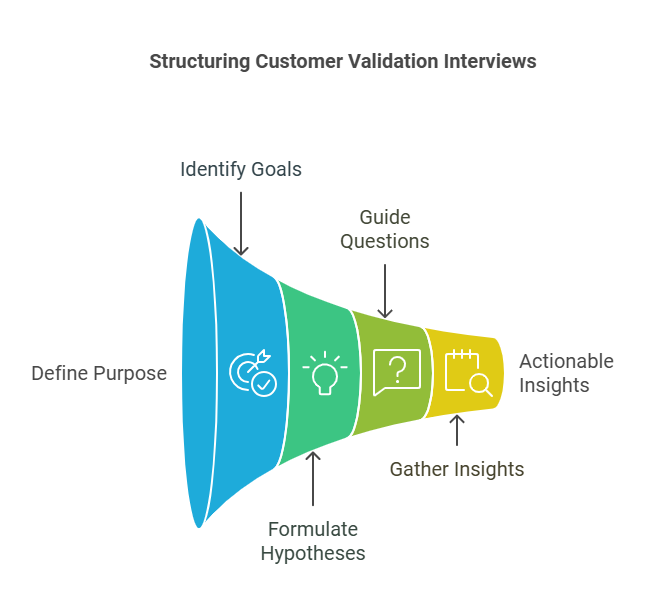 Structuring Customer Validation interviews
Structuring Customer Validation interviews
Choose the Right Interview Format
The format of your interviews can significantly impact the quality of insights you gather. Selecting the right medium—whether in-person, video calls, or phone—depends on your goals and the preferences of your audience.
- In-person interviews offer the advantage of building rapport and observing nonverbal cues such as body language. They’re particularly useful when exploring sensitive or complex topics.
- Video calls strike a balance between convenience and engagement. They allow for visual interactions and can provide a sense of connection without requiring physical presence.
- Phone interviews are ideal for participants who value flexibility or reside in remote locations. However, the lack of visual cues may limit the depth of understanding.
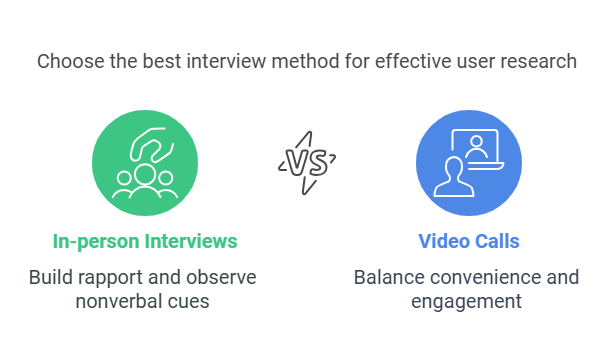
Weigh the pros and cons of each format based on the context of your research, and choose the one that aligns best with your objectives.
Prepare an Interview Guide
A well-crafted interview guide is your roadmap to a successful conversation. Begin by outlining the key topics and questions you want to cover, ensuring they align with your goals and hypotheses. Focus on open-ended questions that encourage detailed responses and avoid leading or biased language.
For instance, instead of asking, "Would you use this feature?", frame it as, "Can you tell me about a time you faced this problem?" Such questions prompt participants to share genuine experiences rather than hypothetical scenarios, yielding more valuable insights.
Structure your guide to flow naturally, starting with general questions to build rapport and ease participants into the conversation. Gradually delve deeper into specific areas of interest, maintaining a conversational tone throughout. Remember to leave room for follow-up questions—some of the most insightful moments often arise from unexpected tangents.
By investing time in preparation, you’ll set the stage for interviews that are not only productive but also insightful, paving the way for meaningful discoveries.
Section 2: Mastering the Art of Conversation
Listen Actively
Active listening is a crucial skill that can elevate the quality of your customer validation interviews. It involves giving participants your full attention, acknowledging their responses, and encouraging them to elaborate. Techniques such as maintaining eye contact, nodding, and using affirming phrases like "That’s interesting, can you tell me more?" demonstrate that you value their input.
Recording interviews (with permission) is another effective way to ensure you don’t miss key details. By reviewing recordings, you can focus fully on the conversation during the interview and later extract accurate insights for analysis.
Ask the Right Questions
The questions you ask will determine the depth and relevance of the insights you gather. Effective, insight-driven questions are designed to explore customers' real experiences and challenges. For example:
- "Can you describe the last time you encountered this problem?"
- "What steps did you take to address it?"
- "How did that solution work for you?"
These types of questions uncover genuine pain points and reveal the context behind customer behaviors. They move beyond surface-level feedback and delve into actionable insights that can inform product decisions.
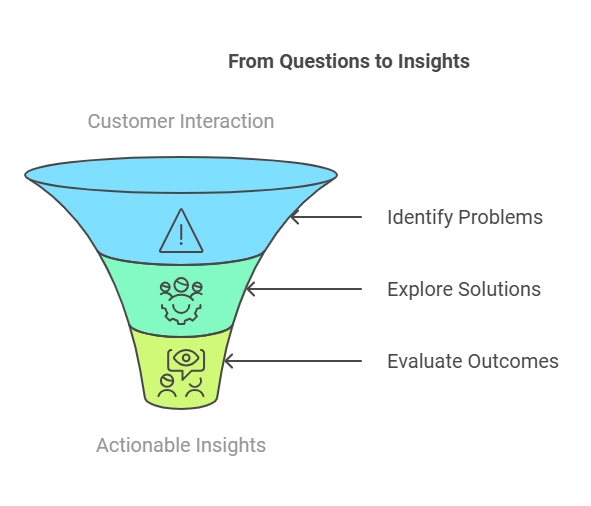
Avoid Hypothetical Scenarios
Hypothetical questions, such as "Would you use this product?", often lead to misleading feedback. People tend to answer based on what they think you want to hear rather than their actual behavior. Instead, focus on real experiences and actions. Ask questions like "What do you currently do to solve this problem?" or "Can you walk me through your typical process?"
This approach minimizes bias and ensures that the feedback you gather is grounded in reality, providing a solid foundation for making informed decisions.
Section 3: Maximizing the Outcomes
Conclude with a Call for Referrals
Ending your interviews with a call for referrals can significantly expand your pool of participants. Ask interviewees if they know others who might share similar challenges or fit the profile you’re researching. A simple request like, "Is there anyone else you think I should talk to about this?" can lead to valuable connections and new perspectives.
To make the process seamless, offer to send an email template or provide a brief explanation they can share with their contacts. This not only increases your reach but also builds goodwill with your participants.
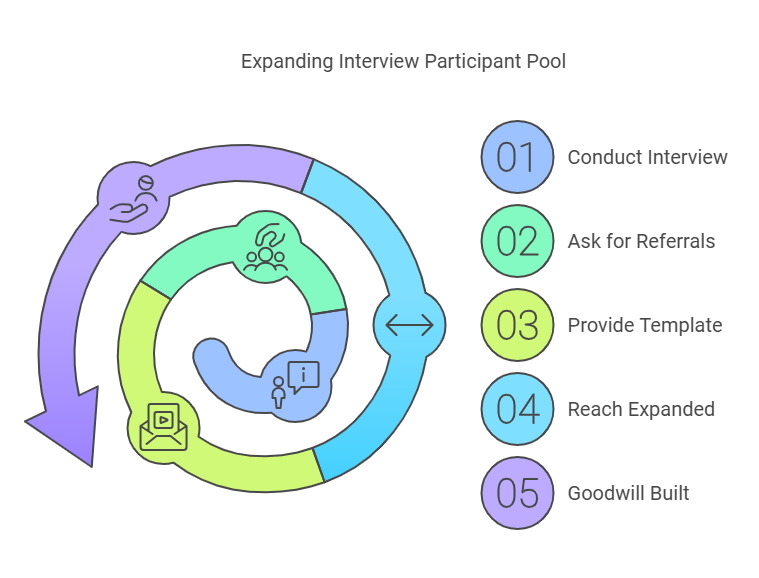
Analyze and Reflect
Reviewing and synthesizing your findings is a critical step in the customer validation process. After each interview, take time to analyze the responses, identifying recurring themes, patterns, and outliers. Group similar insights together and highlight actionable takeaways that can guide your next steps.
Tools such as mind maps, spreadsheets, or qualitative analysis software can help you organize and interpret the data. The goal is to distill the wealth of information into clear, impactful insights that drive decision-making.
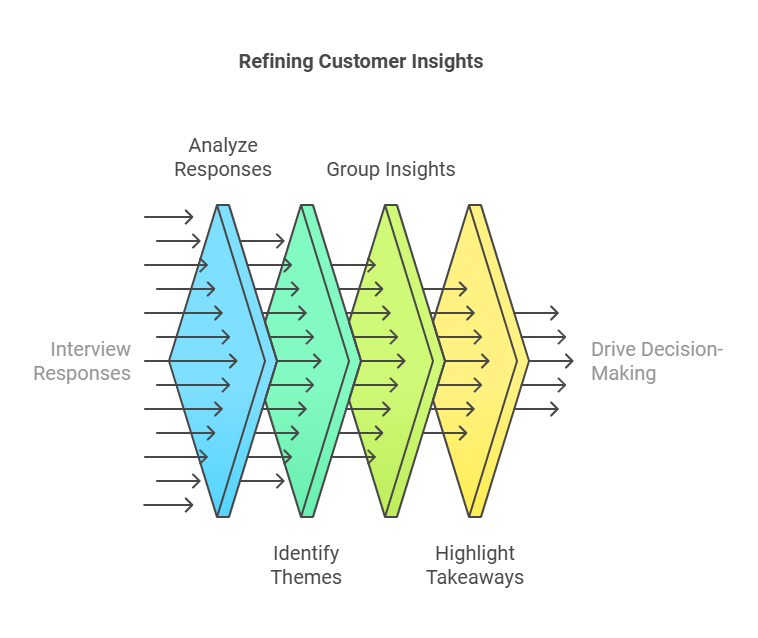
Iterate and Adapt
Customer validation is an iterative process. Each interview should inform the next, refining your approach as you go. Pay attention to what works and what doesn’t, adjusting your questions, interview style, or recruitment methods based on the feedback you’ve gathered.
By remaining flexible and open to change, you’ll continuously improve the quality of your interviews, leading to deeper insights and a more accurate understanding of your target audience.
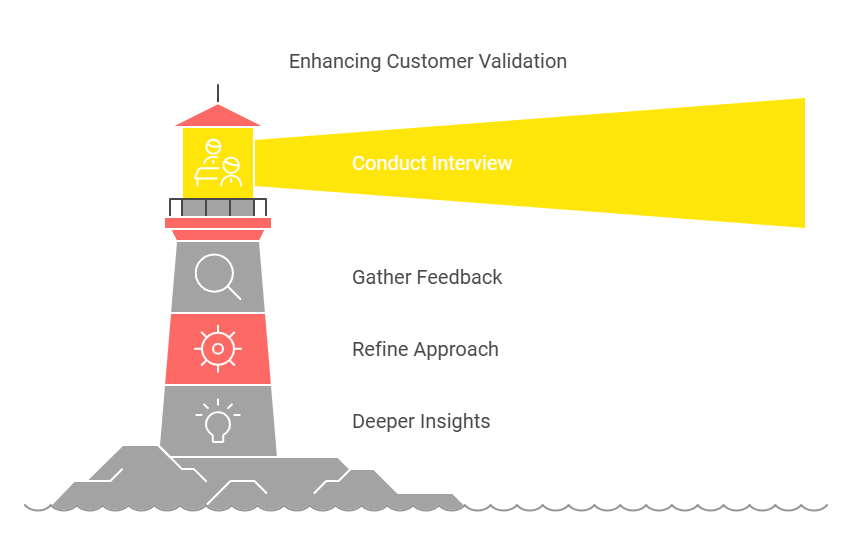
Conclusion
Effective customer validation interviews are a cornerstone for creating products and services that resonate with your target audience. By following the nine actionable tips outlined in this blog, you can dramatically enhance the quality and impact of these conversations:
- Define clear goals and hypotheses.
- Choose the right interview format.
- Prepare an insightful interview guide.
- Listen actively.
- Ask the right questions.
- Avoid hypothetical scenarios.
- Conclude with a call for referrals.
- Analyze and reflect on insights.
- Iterate and adapt your approach.
Each tip plays a critical role in refining your understanding of customer needs, uncovering pain points, and identifying opportunities to improve your offering. The effort you invest in mastering these strategies will translate into more meaningful insights and a stronger connection to your audience.
Remember, customer validation is not a one-time event but a continuous learning process. The more you engage with real users and adapt based on their feedback, the closer you’ll get to achieving product-market fit.
Call-to-Action (CTA)
Are you ready to take your customer validation to the next level? Subscribe to our newsletter for more expert tips and exclusive resources, including a free guide on conducting high-impact customer interviews.
Found this article helpful? Share it with your colleagues or on social media to spread the word about the power of effective customer validation. We’d also love to hear your thoughts or additional tips—drop them in the comments below!
